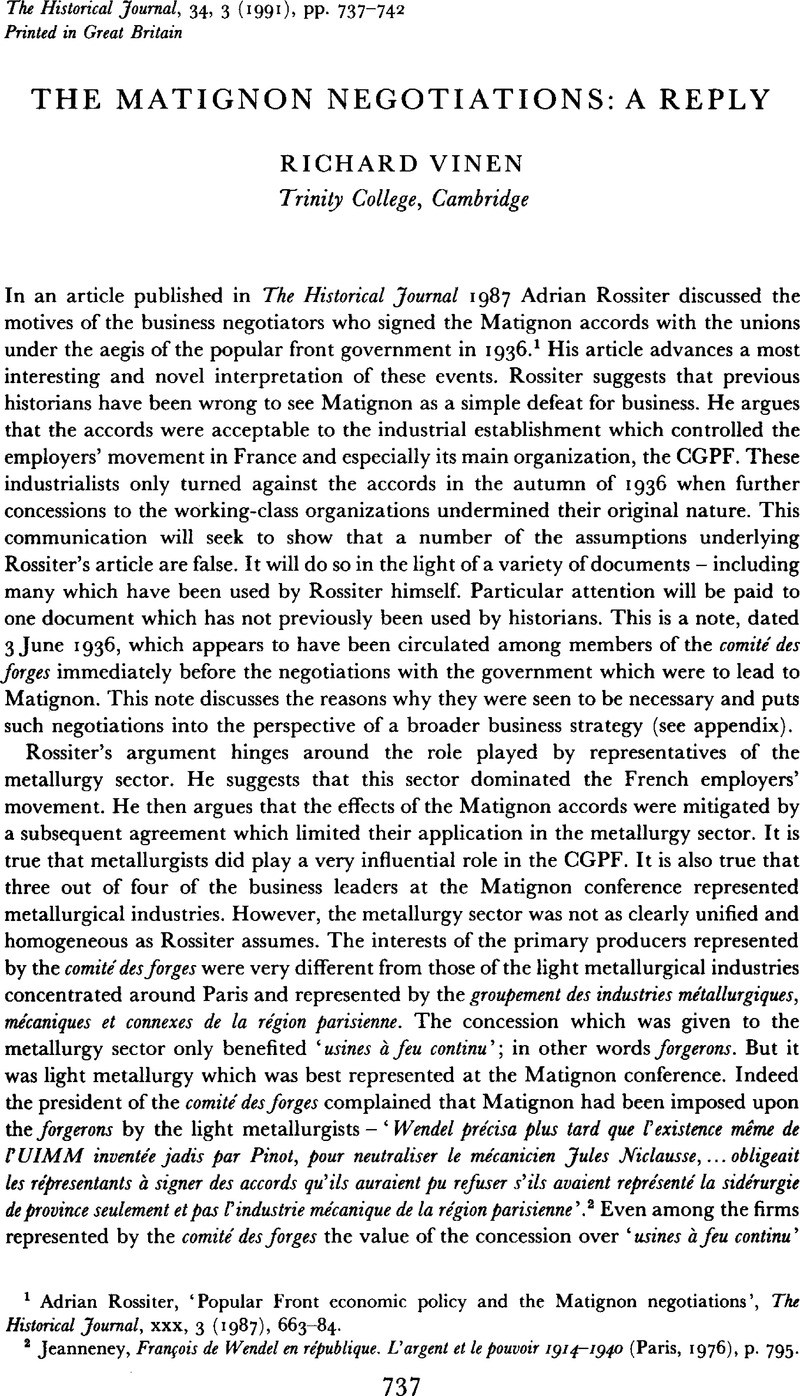No CrossRef data available.
Article contents
The Matignon Negotiations: A Reply
Published online by Cambridge University Press: 11 February 2009
Abstract

- Type
- Communications
- Information
- Copyright
- Copyright © Cambridge University Press 1991
References
1 Rossiter, Adrian, ‘Popular Front economic policy and the Matignon negotiations’, The Historical Journal, XXX, 3 (1987), 663–84CrossRefGoogle Scholar.
2 , Jeanneney, François de Wendel en république. L'argent et le pouvoir 1914–1940 (Paris, 1976), p. 795Google Scholar.
3 Pont à Mousson archives (P à M) 41592. Report of meeting of comité des forges of 15 October 1936.
4 Rossiter enlarged upon these points in an earlier version of his paper which was presented to the Southampton conference on the Popular Fronts in 1986 – ‘They could demand that their voice was given a privileged hearing in negotiations – they were, after all, important purveyors of government orders, particularly during a period of rearmament’ (unpublished paper in the possession of the author, p. 31). Rossiter adds that these industries had the ‘resources to contemplate setting up an alternative trade union structure if this ultimately became necessary’ (ibid.). This statement is questionable – if large-scale metallurgy had been capable of establishing yellow unions it would have done so years before 1936 and the strikes would never have occurred. In fact the workforce in these industries was one of the most unionized and communist controlled in France.
5 , Rossiter, ‘Popular Front economic policy’, p. 679Google Scholar.
6 A Pont à Mousson manager complained on 18 October 1937 that industry was divided between ‘celles qui touchent de près ou de loin aux industries de guerre’ and the rest (P à M, 41604).
7 , Rossiter, ‘Experiments with corporatist politics in Republican France, 1916–1939’ (unpublished D.Phil, dissertation, University of Oxford, 1986), p. 299Google Scholar – ‘To put it briefly, my point is that Duchemin may well have been ousted by the intervention of heavy industry, but if so it may well have been because he seemed to be getting too friendly with the PMEs.’
8 Pont à Mousson were certainly unaware of any coup against Duchemin. They simply remarked that his departure was ‘sans raison donnée’ (P à M 41604, report of UIMM meeting of 15 October 1936).
9 , Kolboom, La revanche des patrons, le patronat français face au front populaire (Paris, 1986), p. 305Google Scholar.
10 P à M, 41604. It was reported in December that Duchemin was one of the businessmen who had accepted the ‘échelle mobile’ ‘pour marquer leur opposition à la CGPF’.
11 , Kolboom, La revanche des patrons, p. 302Google Scholar.
12 , Rossiter, ‘Experiments with corporatist politics’, p. 300Google Scholar. The words which Rossiter omits from this quotation are – ‘que M Lambert Ribot ne nommait pas mais dont tout le monde donne le nom’ (P à M, 41952).
13 Ibid.
14 Paris, Archives Nationales (AN), 91 AQ 78. ‘La naissance de l'organisation ‘B’ et la manière de contrôle que ‘B’ a pretendu exerciser, peut être un peu maladroit pendant la période électorale ont découragé et un peu dégoûté l' UIE’. Rossiter has not consulted the original of this document; he relies upon the extract cited in , Fridenson, Histoire des usines Renault: Naissance de la grande entreprise, 1898–1939 (Paris, 1972)Google Scholar. But he dismisses Fridenson's own warning that ‘B’ was founded before the elections of 1936. It is just possible that ‘la période électorale’ refers to the electoral campaign within the CGPF in which case ‘B’ might be the Brenot group (which had campaigned fairly vigorously during the summer of 1936). For what it is worth, my guess is that ‘B’ is the Groupement de Défense des Libertés Economiques. This organization had been founded in 1935, and it attracted great interest from Renault. Furthermore, in one of its first circulars it had alluded to the possibility of conflict with other organizations (pamphlet of February 1935 in AN, 91 AQ78).
15 A number of groups which were brought into the CGPF in 1936 as representatives of ‘small business’ had previously been affiliated to the UIE (see , Kolboom, La revanche des patrons, p. 82)Google Scholar.
16 , Rossiter, ‘Experiments with corporatist politics’, p. 291Google Scholar. Rossiter claims that Bernard led the ‘textile dominated AICA’. There is no evidence whatsoever that AICA was dominated by the textile industry.


